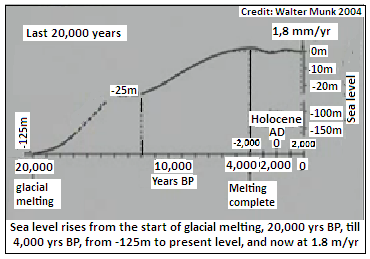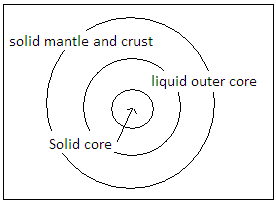Timekeeping may yet work as a good measure of sea level rise, says S.Ananthanarayanan.
Redistribution of water on the earth’s surface because of melting of polar ice, while the equatorial sea level rises, has been linked to imperceptible slowing of the earth’s rotation since thousands of years. Sea levels rise both due to water flowing in from melting ice and also because the water is warming. With global warming during the last century, melting of ice and warming of the sea have increased and so has sea level rise, which now threatens coastal cities world-wide.
Jerry X. Mitrovica, Carling C. Hay, Eric Morrow, Robert E. Kopp, Mathieu Dumberry and Sabine Stanley, from the universities of Harvard, Rutgers, Alberta, Grenoble and Toronto explain in the journal, Science Advances that they have refined the way of considering available data so that a serious question about whether the speed of the earth’s rotation could be used as a measure of the creeping rise in the sea level is resolved. Getting a correct estimate of how fast the sea level is rising is vital to help coastal cities plan investments for adaptation, from moving coastal structures inland to building dykes, even to modify drainage and sewage treatment according to the changed hydraulics in a warming world.
That the earth’s speed of rotation is changing was first noticed by Isaac Newton’s contemporary, the astronomer, Edmund Halley. With the help of Newton’s mechanics of planetary motion, Halley made important contributions to the study of eclipses. He created the first eclipse map and rediscovered the Saros cycle, a pattern of eclipses used by the Chaldeans, Babylonians and later by the Greeks, to foretell the timing of eclipses. With the help of Newton’s methods, Halley was then able to calculate the timing of ancient eclipses in historical records. But this is where he found that the timing did not match, in the sense that an eclipse that should have occurred in Babylon occurred instead a thousand miles to the east or west. It seemed that either the orbit of the moon was speeding up or the rotation of the earth was slowing down. Both effects, in fact, were there, and the slowing of the earth was the main reason.
Reason for slowing
One reason for the earth slowing down is that energy is lost as a result of tides, in the oceans and also in the land mass, caused mainly by the moon. While the energy lost by the earth is partly gained by the moon, which then drifts away from the earth by a distance of 3.8 cm per year, the length of the day on the earth gets longer by about 2 milliseconds every century. Such gradual slowing also adds up, for 2 milliseconds a day is 2/3 of a second in a year, or some 70 seconds in a century. And hence the large differences in timing of eclipses since the time of the Babylonians.
Tides, however, are only one of the reasons that the earth slows down. Another reason is when there is warming and ice at the poles melts and moves down towards the equator. The rotating earth can be likened to a spinning figure skater. The mass of a spinning object that is further away from the axis of spin contains more of the spinning momentum than the mass the axis. The spinning figure skater would thus slow down if she stretched her arms out and speed up if she drew them in. In the same way, when part of the mass of the earth in the form of ice at the poles, which is nearer the axis of rotation, moves to wards the equator and hence away from the axis, the earth has to slow down. Increase in the diameter of the earth by 1 mm can thus slow the earth down by about half a second per year every century. The actual sea level rise during 1900-1990 was 1.8 mm per year, or 18 cm over the century.

Yet another factor affecting the earth’s speed of rotation is the flow of the material of the earth itself, as a result of the rotation. The spin tends to throw matter out, away from the axis, which is towards the equator, and the earth has assumed an oval or oblate shape. This squeezing out at the equator is also maintained by the load of ice that has formed at the poles. When this ice begins to melt, the pressure is relieved and the squeezing relaxes, which reduces the bulge at the equator, an effect that would increase the speed of rotation. This is an effect that has been in action since the last major glaciation, which was 20,000 years ago. And a further factor in the picture is exchange of energy between the molten, fluid outer core of the earth and the surrounding mantle.

Acceleration or deceleration of the outer portion of a sphere is retarded by a liquid interior which is not rigidly connected with the outer portion. It is like spinning a raw egg. It is difficult to get the egg spinning, and once it is spinning, it cannot be easily stopped. But a hard-boiled egg does not behave like this
Munk's Enigma
With the help of atomic clocks and astronomical observations, scientists are now able to estimate the speed of the earth’s rotation with great accuracy. This ability could become a sensitive instrument to monitor the rate of sea level rise, provided the correct relationship could be discovered. Although there are now accurate satellite measurements of sea levels, data for earlier periods, till 1990, comes from tide-gauge readings maintained at many sea ports and harbours. Professor Walter Heinrich Munk, a celebrated US oceanographer, analysed the historical rotation speed of the earth, over the last 3,000 years, as discovered from Babylonian, Chinese, Greek, Arab eclipse records. He found that the variation in the rate of rotation of the earth, over the period, after accounting for the effect of expansion due to warming and also the migration of earth material from the equator to the poles, as a result of the higher latitudes being relieved of the load of glaciers, does not agree the implied flow of water from melting ice sheets, and hence the sea level rise. This discrepancy, which is based on uncertainty of data and makes the findings of oceanographers and climate experts questionable, has come to be known as the >Munk’s enigma.
The group writing Science Advances report in their paper that the expression of the enigma by Munk indicates the way to correct how the uncertain data that is available should be considered. They find that results become more consistent by accepting a lower estimate for the mean sea level rise for the 20th century, an improved model, based on independent data, for the flow of earth material towards the poles and then by carrying out a computation, based on geomagnetic data, to account for the interaction of earth’s mantle-crust with the liquid, outer core.
“Confronting Munk’s elegant statement of the enigma has thus improved our understanding of Earth’s rotation spanning the last three millennia and the individual sources of sea-level rise in the century before the early 1990s. The reconciliation also adds confidence to ongoing efforts to project this rise to the end of the current century and beyond,” the authors of the paper say.
------------------------------------------------------------------------------------------
